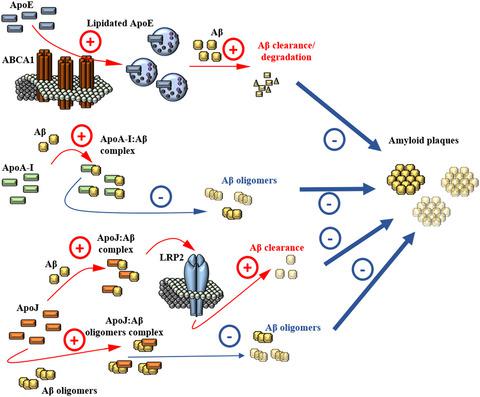当前位置:
X-MOL 学术
›
J. Neurochem.
›
论文详情
Our official English website, www.x-mol.net, welcomes your
feedback! (Note: you will need to create a separate account there.)
High-density lipoprotein-related cholesterol metabolism in Alzheimer’s disease
Journal of Neurochemistry ( IF 4.2 ) Pub Date : 2020-09-05 , DOI: 10.1111/jnc.15170 Steve Pedrini 1 , Pratishtha Chatterjee 1, 2 , Eugene Hone 1 , Ralph N Martins 1, 2, 3
Journal of Neurochemistry ( IF 4.2 ) Pub Date : 2020-09-05 , DOI: 10.1111/jnc.15170 Steve Pedrini 1 , Pratishtha Chatterjee 1, 2 , Eugene Hone 1 , Ralph N Martins 1, 2, 3
Affiliation

|
High-density lipoproteins (HDL) are a heterogeneous class of molecules whose main function is to remove excess cholesterol through a mechanism called reverse transport, in which cholesterol is transported from peripheral organs and from arterial foam cells to the liver, where it is subsequently eliminated with bile. While its ability to eliminate excess cholesterol has always been viewed as its main feature, its beneficial effects go beyond this single effect. Many of the proteins that are associated with HDL are responsible for anti-oxidant and anti-inflammatory properties. These proteins that are associated with HDL during its generation and remodelling, are referred to as ‘protein cargo’, which has been extensively analysed by mass spectrometry analysis in healthy and diseased individuals. In this review, we discuss the pathway that leads to HDL formation and its subsequent remodelling and catabolism with regards to the possible involvement of HDL ‘protein cargo’ in Alzheimer's disease.
中文翻译:

阿尔茨海默病中高密度脂蛋白相关的胆固醇代谢
高密度脂蛋白 (HDL) 是一类异质分子,其主要功能是通过一种称为逆向转运的机制去除多余的胆固醇,其中胆固醇从外周器官和动脉泡沫细胞转运到肝脏,然后在那里被消除用胆汁。虽然其消除多余胆固醇的能力一直被视为其主要特征,但其有益效果超出了这一单一效果。许多与 HDL 相关的蛋白质具有抗氧化和抗炎特性。这些在其生成和重塑过程中与 HDL 相关的蛋白质被称为“蛋白质货物”,已通过质谱分析对健康和患病个体进行了广泛的分析。在这次审查中,
更新日期:2020-09-05
中文翻译:

阿尔茨海默病中高密度脂蛋白相关的胆固醇代谢
高密度脂蛋白 (HDL) 是一类异质分子,其主要功能是通过一种称为逆向转运的机制去除多余的胆固醇,其中胆固醇从外周器官和动脉泡沫细胞转运到肝脏,然后在那里被消除用胆汁。虽然其消除多余胆固醇的能力一直被视为其主要特征,但其有益效果超出了这一单一效果。许多与 HDL 相关的蛋白质具有抗氧化和抗炎特性。这些在其生成和重塑过程中与 HDL 相关的蛋白质被称为“蛋白质货物”,已通过质谱分析对健康和患病个体进行了广泛的分析。在这次审查中,











































 京公网安备 11010802027423号
京公网安备 11010802027423号